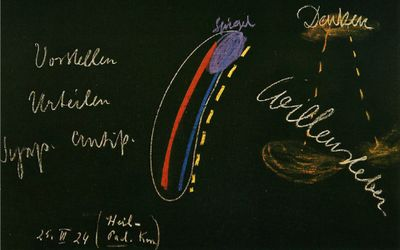Nerve-sense system
The nerve-sense system is the most elevated part of the threefold human organism. It is mainly centred in the head and forms the immediate physical tool for sensory perception, imagining and thinking. It gives man the basis for his waking daytime consciousness, with which he grasps the sensory world.
Rudolf Steiner also refers to the nervous-sensory system as the synthetic system, since it combines the activity of the whole organism in itself:

„This system, this nerve-sense system is localised in the head, in the main body. It is a synthetic system.
It is synthetic. What do I mean by that? It brings together all the activities of the organism. You see, in the head the whole human being is actually contained in a certain way. When one speaks of liver activity, and one should really only speak of liver activity - what I see as liver is the fixed liver process - this liver activity is naturally entirely in the lower body. But to every such functional connection corresponds an activity in the human head. If I draw this schematically (see Plate 1, right), it is like this: Here is the liver activity. This liver activity corresponds to some activity in the human head or brain. Here in the abdomen the liver is relatively separated from the other organs, kidneys, stomach and so on. In the brain everything flows into one another, there the liver activity flows together with the other activities, so that the head is the great compiler of all that goes on in the organism. Through this synthetic activity a process of decomposition is brought about. The substantial falls out.
Just as we have a synthetic process in the head, so we have an analytical process in the whole of the rest of the organism, especially in the metabolic limb system. There everything is kept apart, there, in contrast to the head, everything is kept apart.“ (Lit.:GA 317, p. 14f)
Feeling, on the other hand, is not based on the nervous system, but on the rhythmic system, which is primarily active in the chest area, and is only secondarily reflected in the form of ideas of feeling through the nervous apparatus. Feeling itself has only a dream-like character in consciousness.
Similarly, willing acts primarily in the metabolic-limb system and is secondarily reflected in ideas of will. The activity of will itself remains completely unconscious, as it corresponds to sleep consciousness.
See also
Literatur
- Rudolf Steiner: Heilpädagogischer Kurs, GA 317 (1995), ISBN 3-7274-3171-7 English: rsarchive.org German: pdf pdf(2) html mobi epub archive.org
 |
References to the work of Rudolf Steiner follow Rudolf Steiner's Collected Works (CW or GA), Rudolf Steiner Verlag, Dornach/Switzerland, unless otherwise stated.
Email: verlag@steinerverlag.com URL: www.steinerverlag.com. Index to the Complete Works of Rudolf Steiner - Aelzina Books A complete list by Volume Number and a full list of known English translations you may also find at Rudolf Steiner's Collected Works Rudolf Steiner Archive - The largest online collection of Rudolf Steiner's books, lectures and articles in English. Rudolf Steiner Audio - Recorded and Read by Dale Brunsvold steinerbooks.org - Anthroposophic Press Inc. (USA) Rudolf Steiner Handbook - Christian Karl's proven standard work for orientation in Rudolf Steiner's Collected Works for free download as PDF. |
